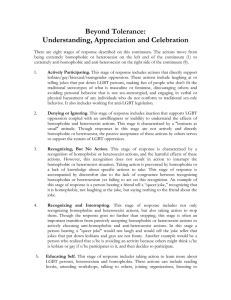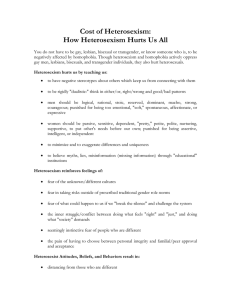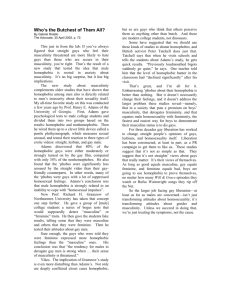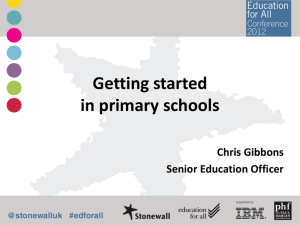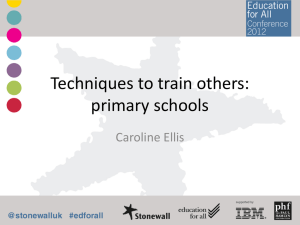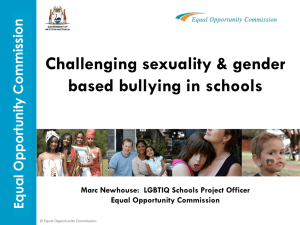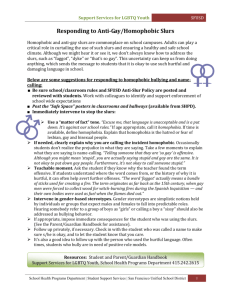Attitude Continuum
advertisement
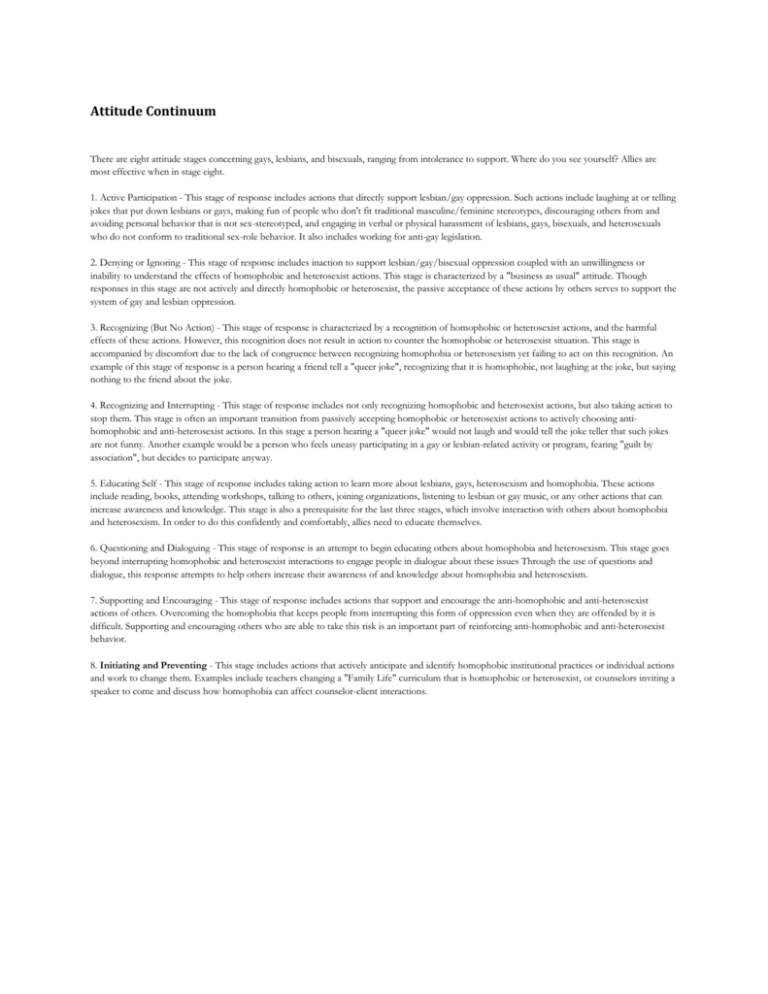
Attitude Continuum There are eight attitude stages concerning gays, lesbians, and bisexuals, ranging from intolerance to support. Where do you see yourself? Allies are most effective when in stage eight. 1. Active Participation - This stage of response includes actions that directly support lesbian/gay oppression. Such actions include laughing at or telling jokes that put down lesbians or gays, making fun of people who don't fit traditional masculine/feminine stereotypes, discouraging others from and avoiding personal behavior that is not sex-stereotyped, and engaging in verbal or physical harassment of lesbians, gays, bisexuals, and heterosexuals who do not conform to traditional sex-role behavior. It also includes working for anti-gay legislation. 2. Denying or Ignoring - This stage of response includes inaction to support lesbian/gay/bisexual oppression coupled with an unwillingness or inability to understand the effects of homophobic and heterosexist actions. This stage is characterized by a "business as usual" attitude. Though responses in this stage are not actively and directly homophobic or heterosexist, the passive acceptance of these actions by others serves to support the system of gay and lesbian oppression. 3. Recognizing (But No Action) - This stage of response is characterized by a recognition of homophobic or heterosexist actions, and the harmful effects of these actions. However, this recognition does not result in action to counter the homophobic or heterosexist situation. This stage is accompanied by discomfort due to the lack of congruence between recognizing homophobia or heterosexism yet failing to act on this recognition. An example of this stage of response is a person hearing a friend tell a "queer joke", recognizing that it is homophobic, not laughing at the joke, but saying nothing to the friend about the joke. 4. Recognizing and Interrupting - This stage of response includes not only recognizing homophobic and heterosexist actions, but also taking action to stop them. This stage is often an important transition from passively accepting homophobic or heterosexist actions to actively choosing antihomophobic and anti-heterosexist actions. In this stage a person hearing a "queer joke" would not laugh and would tell the joke teller that such jokes are not funny. Another example would be a person who feels uneasy participating in a gay or lesbian-related activity or program, fearing "guilt by association", but decides to participate anyway. 5. Educating Self - This stage of response includes taking action to learn more about lesbians, gays, heterosexism and homophobia. These actions include reading, books, attending workshops, talking to others, joining organizations, listening to lesbian or gay music, or any other actions that can increase awareness and knowledge. This stage is also a prerequisite for the last three stages, which involve interaction with others about homophobia and heterosexism. In order to do this confidently and comfortably, allies need to educate themselves. 6. Questioning and Dialoguing - This stage of response is an attempt to begin educating others about homophobia and heterosexism. This stage goes beyond interrupting homophobic and heterosexist interactions to engage people in dialogue about these issues Through the use of questions and dialogue, this response attempts to help others increase their awareness of and knowledge about homophobia and heterosexism. 7. Supporting and Encouraging - This stage of response includes actions that support and encourage the anti-homophobic and anti-heterosexist actions of others. Overcoming the homophobia that keeps people from interrupting this form of oppression even when they are offended by it is difficult. Supporting and encouraging others who are able to take this risk is an important part of reinforcing anti-homophobic and anti-heterosexist behavior. 8. Initiating and Preventing - This stage includes actions that actively anticipate and identify homophobic institutional practices or individual actions and work to change them. Examples include teachers changing a "Family Life" curriculum that is homophobic or heterosexist, or counselors inviting a speaker to come and discuss how homophobia can affect counselor-client interactions.

